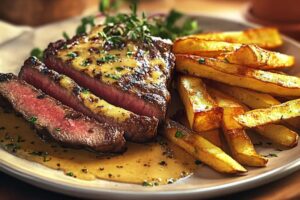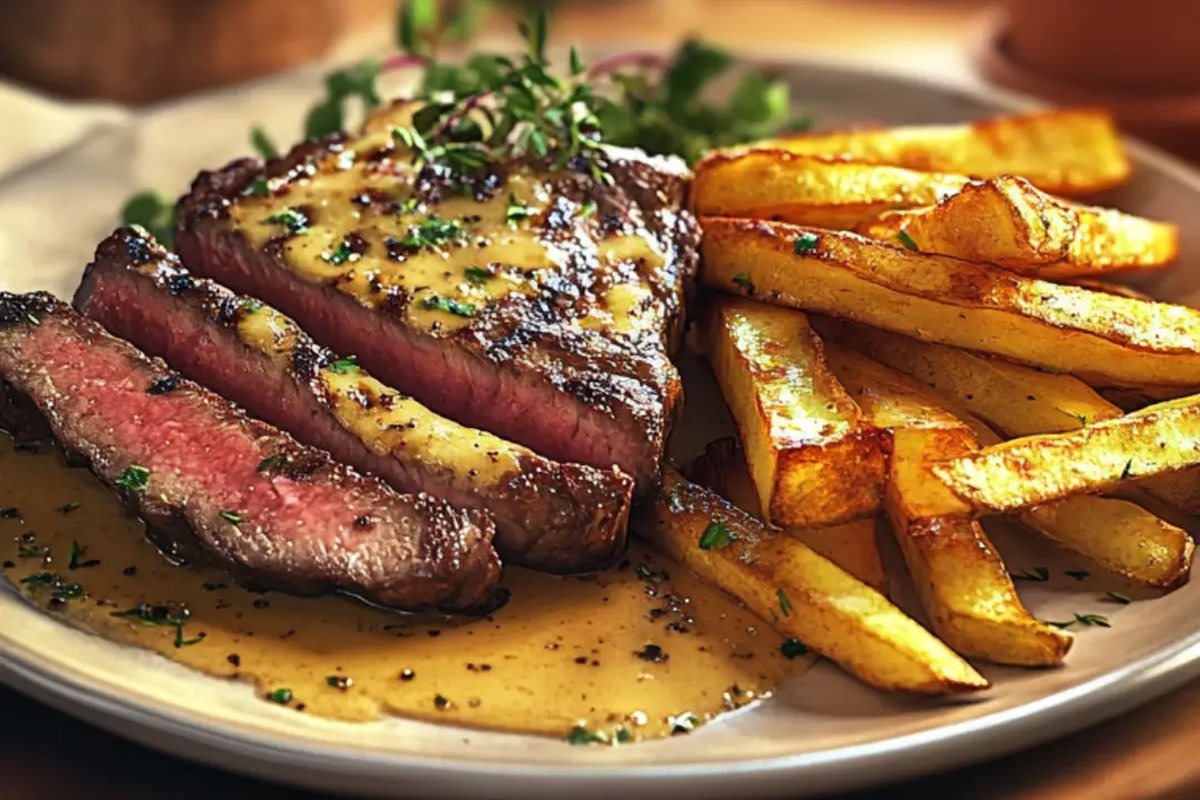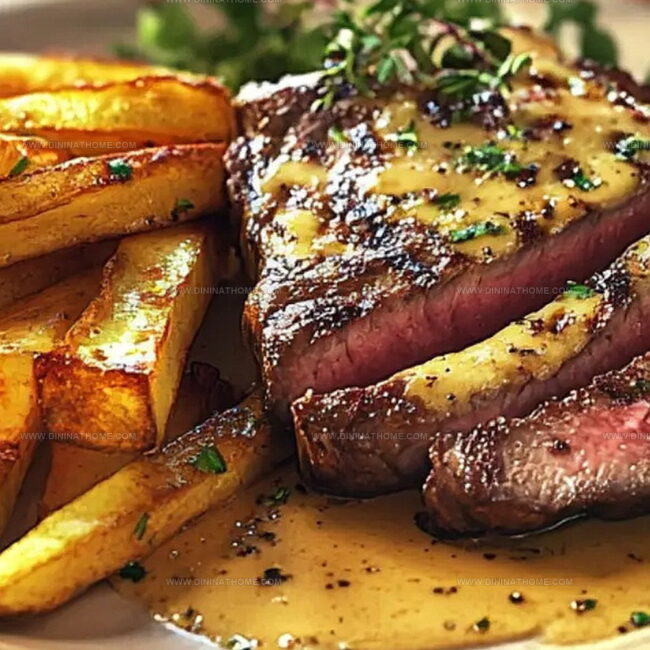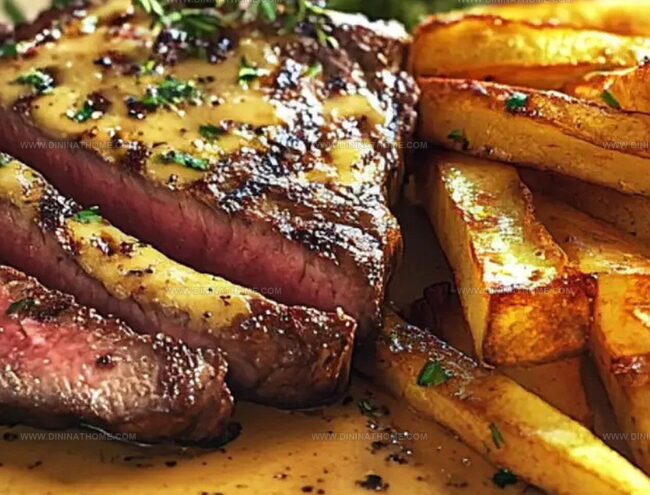Sizzling Steak Frites Recipe: Homemade Bistro Magic
Culinary magic happens when you master this classic steak frites recipe that transports you straight to a Parisian bistro.
Crisp golden fries complement a perfectly seared cut of beef in a dance of flavors.
Salt and pepper become your secret weapons for creating restaurant-quality magic at home.
Each bite promises a delectable journey through French cuisine’s most beloved dish.
Tender meat paired with impossibly crunchy potatoes will make you feel like a professional chef.
Simple ingredients merge into an extraordinary meal that impresses without complicated techniques.
I promise this recipe will become your new weekend favorite that everyone asks you to make again.
Steak Frites Everyone Craves For Its Classic Comfort
Savor Culinary Perfection: Delightful Reasons to Love Steak Frites
Steak Frites Recipe What You’ll Need
Main Ingredients:Herbs and Aromatics:Liquid and Dairy Components:Additional Seasonings:Steak Frites Prep from Sear to Crispy Fries
Step 1: Prepare Potato Base
Wash and peel potatoes, cutting them into uniform french fry shapes.
Submerge potato strips in icy water for several hours to eliminate excess starch.
Drain completely and thoroughly dry using clean kitchen towels.
Step 2: Initial Potato Frying
Select a deep pan and heat oil to a moderate temperature around 275°F.
Gently lower potato strips into oil, cooking in small batches until softened but not colored.
Transfer fries onto paper towels, then spread on a baking sheet.
Freeze for approximately 45 minutes to solidify texture.
Step 3: Season Beef Centerpiece
Remove ribeye steaks from refrigeration.
Generously sprinkle kosher salt across both surfaces.
Allow meat to rest at room temperature before cooking to ensure even heat distribution.
Step 4: Create Elegant Sauce
Gather ingredients:Combine shallots and herbs in a skillet, reducing liquid completely.
Whisk egg yolks with melted butter over gentle heat until silky and pale.
Incorporate herb mixture and seasonings.
Slowly blend remaining butter to create smooth consistency.
Step 5: Sear Succulent Steaks
Heat cast-iron skillet until extremely hot.
Pat steaks dry with paper towels.
Sear each side for roughly 3 minutes, adjusting time based on desired doneness.
Let meat rest momentarily before slicing.
Step 6: Crisp Potato Finale
Increase oil temperature to 375°F.
Fry potato strips in batches until achieving golden, crunchy exterior.
Drain excess oil and sprinkle with sea salt.
Step 7: Artful Plating
Arrange seared steak alongside crispy frites.
Drizzle sauce directly over meat or serve separately for dipping.
Garnish with fresh chopped chives for elegant presentation.
Steak Frites Cooking Tips with French-Style Flair
Keep Steak Frites Warm
Sides for Steak Frites
Steak Frites with Creative Touches
FAQs
Béarnaise is a classic French sauce made with egg yolks, butter, and herbs like tarragon and chives. It’s unique because of its rich, creamy texture and tangy herb flavor that perfectly complements grilled meats.
Ribeye is ideal, but you can use other tender cuts like sirloin or New York strip. Just ensure the steak is well-marbled and thick enough to achieve a nice medium-rare doneness.
Soaking removes excess starch, which helps create crispier fries with a fluffy interior. It also prevents the potatoes from sticking together during frying and ensures a more even cooking process.
Yes, freezing helps dry out the potato surface and creates a crispier exterior. This double-frying technique is a classic French method that results in golden, crunchy fries with a soft center.
Print
Steak Frites Recipe
- Total Time: 1 hour 45 minutes
- Yield: 8 1x
Description
Sizzling French-style Steak Frites brings classic Parisian bistro magic right to home kitchens with perfectly seasoned beef and crispy golden potatoes. Culinary enthusiasts will savor this simple yet elegant dish that promises restaurant-quality flavor without leaving home.
Ingredients
Proteins:
- 2 ribeye steaks
- 12 egg yolks
Herbs and Seasonings:
- 1.5 tablespoons (1.5 tbsp) fresh tarragon, chopped
- 1 teaspoon (1 tsp) dried tarragon
- 1 tablespoon (1 tbsp) fresh chives, chopped (plus extra for garnish)
- 1/4 teaspoon (1/4 tsp) white pepper
- Salt, to taste
- 2 dashes Tabasco sauce
Cooking Components:
- 1 shallot, finely diced (brunoise)
- 2 1/2 teaspoons (2.5 tsp) red wine vinegar
- 8 ounces (8 oz) unsalted butter, melted and cooled
- 4 russet potatoes
- Neutral oil (e.g., canola or vegetable oil) for frying
- Fresh parsley, chopped (optional)
Instructions
- Meticulously wash and peel potatoes, slicing them into uniform fry shapes. Submerge potato strips in ice-cold water to eliminate excess starch, allowing them to soak for several hours or overnight.
- Thoroughly drain potato strips and carefully pat them completely dry using clean kitchen towels.
- Warm cooking oil to a precise 275°F in a deep pan, preparing for initial potato blanching. Gently lower potato strips into the oil, frying in small batches until they turn soft but remain pale.
- Extract fries using a slotted spoon, transferring them onto paper towels to absorb excess oil. Arrange the par-cooked fries on a baking sheet and place in the freezer to solidify.
- Season ribeye steaks generously with salt, allowing them to cure in the refrigerator. Remove steaks approximately 30 minutes before cooking to reach room temperature.
- Create the herb-infused sauce by combining finely chopped shallots, tarragon, and chives with red wine vinegar in a skillet. Reduce until liquid disappears completely.
- In a separate bowl, whisk egg yolks with melted butter, incorporating the herb mixture, white pepper, and Tabasco. Maintain a gentle heat using a water bath, whisking until the mixture transforms into a pale, creamy consistency.
- Gradually incorporate remaining butter while continuously whisking to create a smooth emulsion. Adjust seasoning with salt and pepper.
- Heat a cast-iron skillet until smoking hot. Carefully dry the steaks and sear each side for precisely 3 minutes, achieving a perfect medium-rare doneness.
- Allow steaks to rest, letting juices redistribute throughout the meat.
- Escalate oil temperature to 375°F for the final potato frying. Submerge potato strips in hot oil, cooking until they transform into golden, crispy delights.
- Immediately season fresh fries with salt and optional parsley upon removal from oil.
- Plate seared steaks alongside crispy fries, presenting the herb-infused sauce either drizzled atop the meat or served separately for personal dipping preference.
- Garnish with additional fresh chives and serve immediately for optimal flavor and temperature.
Notes
- Soak potatoes in ice water to achieve crispy, golden fries with a fluffy interior by removing excess starch.
- Pat steaks completely dry before searing to ensure a perfect golden-brown crust and maximum flavor development.
- Use a meat thermometer for precise doneness, aiming for 125°F for medium-rare to guarantee tender, juicy steak every time.
- Customize the sauce by adjusting herb quantities or adding a splash of white wine for extra depth and complexity in the Béarnaise-style sauce.
- Prep Time: 1 hour
- Cook Time: 45 minutes
- Category: Dinner
- Method: Frying
- Cuisine: French
Nutrition
- Serving Size: 8
- Calories: 650
- Sugar: 1 g
- Sodium: 500 mg
- Fat: 45 g
- Saturated Fat: 25 g
- Unsaturated Fat: 20 g
- Trans Fat: 0 g
- Carbohydrates: 30 g
- Fiber: 3 g
- Protein: 40 g
- Cholesterol: 300 mg




James Walker
Lead Recipe Developer & Culinary Educator
Expertise
Southern Cuisine & Farm-to-Table Cooking, Recipe Development & Testing, Culinary Education & Instruction
Education
School: Auguste Escoffier School of Culinary Arts
Program: Diploma in Culinary Arts and Operations
Focus: Comprehensive training in classical and modern culinary techniques, kitchen operations, and farm-to-table practices.
James didn’t learn cooking from a TV show, he learned it from busy kitchens, family gatherings, and long afternoons spent testing recipes the hard way.
After training at the Auguste Escoffier School of Culinary Arts, he brought his love for real, down-to-earth food to every dish he makes.
At Dining At Home, James loves building recipes that feel familiar but still have something special, like adding a twist to a classic or making a slow Sunday dinner feel brand new.
When he’s not in the kitchen, you’ll probably find him swapping garden tips at the farmers’ market or teaching his daughter how to flip pancakes without a mess (almost).